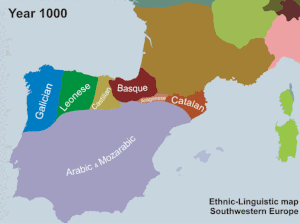
Back Idioma mozarabe AN اللغة المستعربية Arabic اللغه المستعربيه ARZ Mozárabe (llingua) AST مست عربی دیلی AZB Мозарабски език Bulgarian Mossàrab Catalan Mozarabische Sprache German Mozaraba lingvo Esperanto Idioma mozárabe Spanish
This article needs additional citations for verification. (September 2021) |
| Andalusi Romance | |
|---|---|
| Mozarabic | |
| לטן / لتن | |
| Region | Al-Andalus |
| Extinct | by the Late Middle Ages |
| Arabic Hebrew Latin[citation needed] | |
| Language codes | |
| ISO 639-3 | mxi |
mxi | |
| Glottolog | moza1249 |

Andalusi Romance, also called Mozarabic[a] or Ajami,[2] refers to the varieties of Ibero-Romance that developed in Al-Andalus, the parts of the medieval Iberian Peninsula under Islamic control. Romance, or vernacular Late Latin, was the common tongue for the great majority of the Iberian population at the time of the Umayyad conquest in the early eighth century, but over the following centuries, it was gradually superseded by Andalusi Arabic as the main spoken language in the Muslim-controlled south. At the same time, as the northern Christian kingdoms pushed south into Al-Andalus, their respective Romance varieties (especially Castilian) gained ground at the expense of Andalusi Romance[3] as well as Arabic. The final extinction of the former may be estimated to 1300 CE.[2]
The medieval Ibero-Romance varieties were broadly similar (with Castilian standing out as an outlier). Andalusi Romance was distinguished from the others primarily not by its linguistic features, but rather by virtue of being written in the Arabic script.[1] What is known or hypothesized about the particular linguistic features of Andalusi Romance is based on relatively sparse evidence, of which the Kharjas are the most important.
- ^ a b c López-Morillas, Consuelo (2000). "Language". The literature of Al-Andalus. New York: Cambridge University Press. doi:10.1017/CHOL9780521471596.004. ISBN 9781139177870.
- ^ a b "Mozarabic language | Britannica". www.britannica.com. Retrieved 2023-06-04.
- ^ Morillas, Consuelo López (2000-08-31), Menocal, María Rosa; Scheindlin, Raymond P.; Sells, Michael (eds.), "Language", The Literature of Al-Andalus (1 ed.), Cambridge University Press, pp. 31–59, doi:10.1017/chol9780521471596.004, ISBN 978-0-521-47159-6, retrieved 2023-02-21,
Romance speakers from all over the peninsula, had they been asked, would have identified their spoken tongue as ladino, certainly not as leonés, navarro, or any other variety. All shades of Hispano-Romance share many linguistic features; only Castilian was anomalous, and in its eventual expansion southward it ruptured a fundamental unity of speech. East, west, and south of Castile, in both Islamic and Christian lands, the most characteristic traits of HispanoRomance recur. Were it not for the historical accident of Castilian expansion, Spanish would sound very different today, and its contrasts with Portuguese and Catalan would stand out in less sharp relief... Andalusi Romance, virtually untouched by outside linguistic influences in the first centuries of its history, may have been doomed from the moment in 1085 when Alfonso VI and his Castilian troops entered Toledo. The dialect of Castile had been forged in the northern mountains, where Basque speakers had never been subjugated and the veneer of Latinization was thin, and many of its features were anomalous within Hispano-Romance. Yet Castile proved as vigorous and expansionist in language as it was in politics and arms. Like an advancing wedge, the kingdom and its language pressed into Arab-held territory. The neighboring kingdoms were also marching southward: Galicia moved down the Atlantic coast, conquering what was to become Portugal, and the Catalan speakers of the northeast expanded along the Mediterranean and across to the Balearic Islands. But Castile encroached on the territory to its west and east, gaining particularly at the expense of León and Navarre, so that the "wedge" soon became a bulge. Within it Castilian, once an isolated minor dialect, came to be the tongue of the whole central peninsula.
Cite error: There are <ref group=lower-alpha> tags or {{efn}} templates on this page, but the references will not show without a {{reflist|group=lower-alpha}} template or {{notelist}} template (see the help page).
© MMXXIII Rich X Search. We shall prevail. All rights reserved. Rich X Search